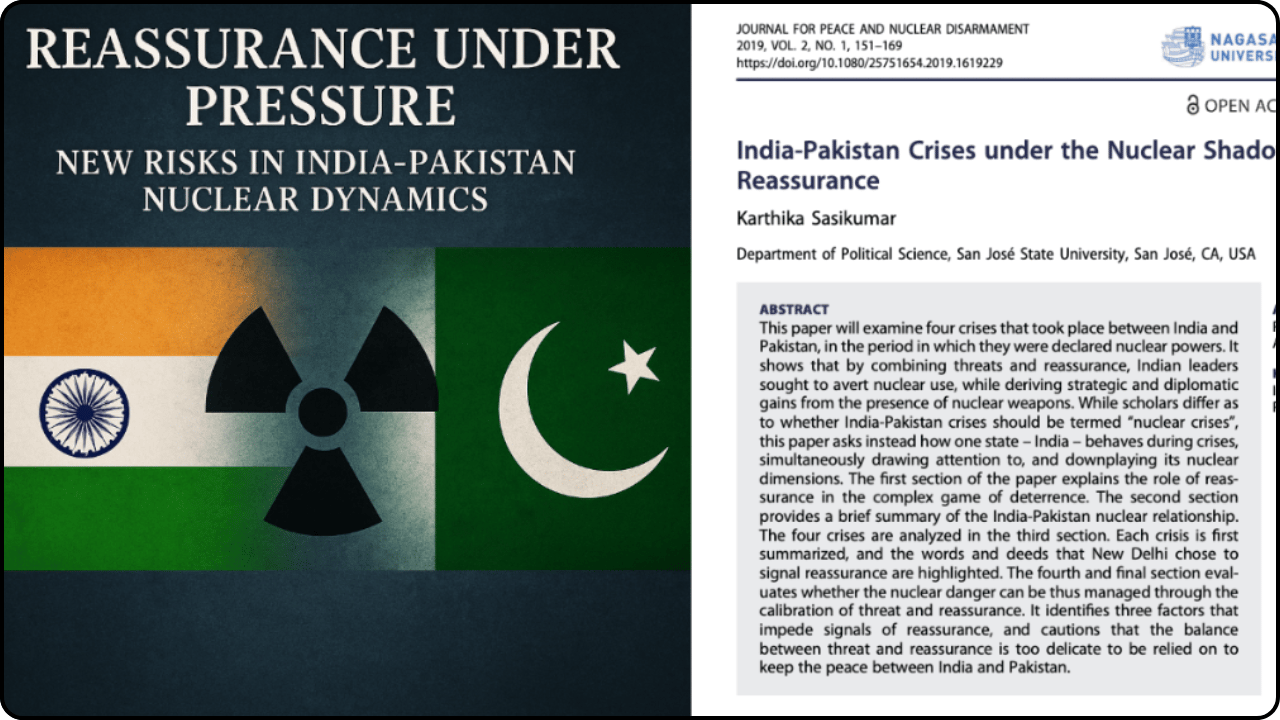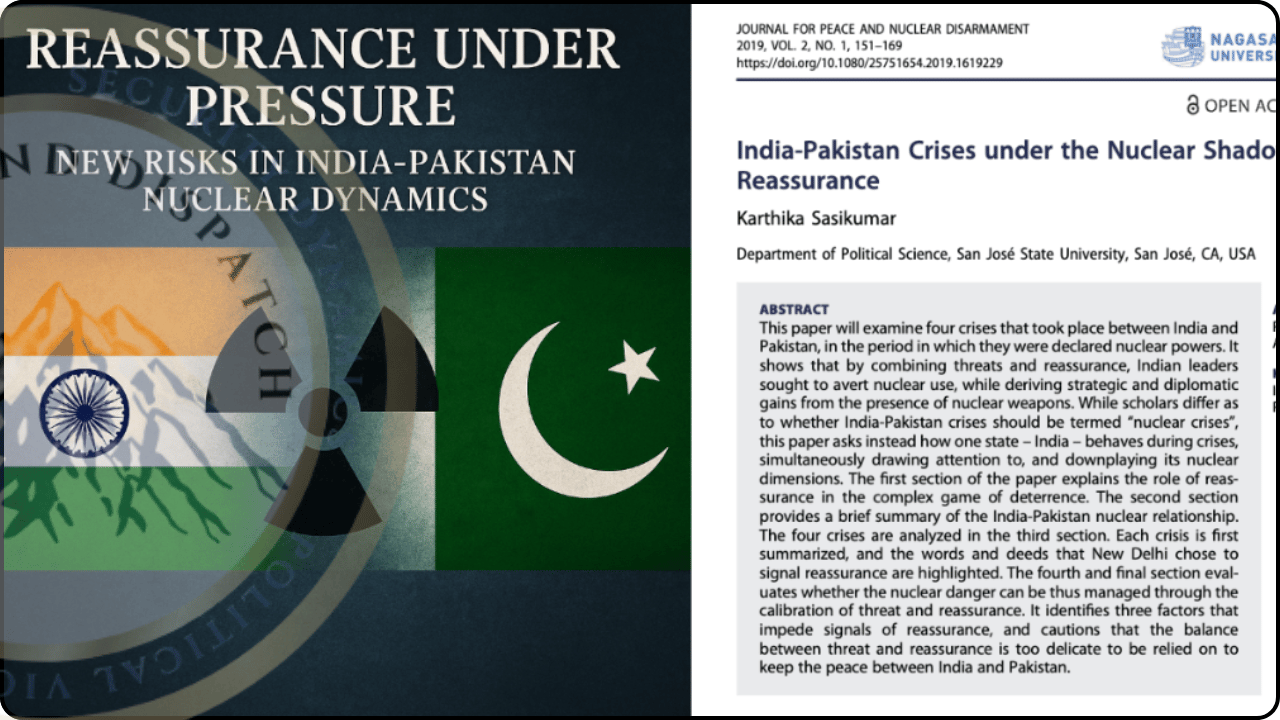In a region where strategic competition increasingly plays out beneath the nuclear umbrella, South Asia presents one of the world's most precarious security environments. The nuclear deterrence relationship between India and Pakistan operates through a complex paradox: while nuclear weapons have prevented full-scale war, they have simultaneously enabled more frequent low-intensity conflicts—what scholars call the stability-instability paradox. As tensions once again escalate in Kashmir following a deadly terrorist attack, insights from academic research on crisis management between nuclear powers take on renewed urgency. Karthika Sasikumar's article "India-Pakistan Crises under the Nuclear Shadow: The Role of Reassurance," published in the Journal for Peace and Nuclear Disarmament, provides a theoretical framework that illuminates the dangerous scenario unfolding today. Sasikumar, a political scientist at San José State University, examines four post-1998 crises between the nuclear-armed neighbors, highlighting how Indian leaders navigated a delicate balance between deterrent threats and reassurance signals to prevent escalation to nuclear use. Sasikumar argues that while nuclear deterrence relies on credible threats of retaliation, equally important are signals of reassurance that help adversaries avoid overreaction and unnecessary escalation.

The Current Crisis in Context
The attack in Pahalgam on April 22, which claimed the lives of 26 tourists, has precipitated one of the most serious crises between India and Pakistan since their 2019 military standoff. In the aftermath, India has suspended the Indus Waters Treaty and closed its airspace to Pakistani airlines, while Pakistan warned of an imminent Indian military strike and mobilized its armed forces. Both nuclear powers have exchanged gunfire along the Line of Control for six consecutive nights.
On May 6-7, 2025, India launched "Operation Sindoor," striking nine sites in Pakistan with missiles that targeted what India described as "terrorist infrastructure," resulting in at least three civilian casualties according to Pakistani authorities. In retaliation, Pakistan claimed to have downed five Indian fighter jets.
This pattern of escalation mirrors several case studies Sasikumar analyzed, particularly the 2008 Mumbai attacks, where a terrorist incident with high civilian casualties attributed to Pakistan-based militants resulted in public outrage and calls for military action within India.

Review: Sasikumar, Karthika. "India-Pakistan Crises Under the Nuclear Shadow: The Role of Reassurance." Journal for Peace and Nuclear Disarmament 2.1 (2019): 151-169.
Reassurance as a Critical Crisis Management Tool
Sasikumar’s analysis of past crises identifies reassurance—not just deterrence—as a critical but often overlooked aspect of nuclear stability. Drawing on the Kargil War (1999), the Twin Peaks crisis (2001–2002), the Mumbai attacks (2008), and the Pulwama-Balakot standoff (2019), she shows that Indian leaders historically managed to send dual signals: resolve through threats, and restraint through reassurance. Examining four post-1998 crises when both nations were declared nuclear powers, the author demonstrates that successful nuclear deterrence requires a delicate balance. India must simultaneously signal its capability and willingness to use nuclear weapons (threat) while also conveying restraint and rational decision-making (reassurance).
The 1999 Kargil War represented India's first test as a nuclear power. Despite losing over 500 soldiers to Pakistani incursions, India deliberately limited its conventional operations, keeping forces on its side of the Line of Control and restricting airpower. These decisions showcased India's commitment to staying below Pakistan's nuclear threshold while demonstrating responsible behavior to the international community.
During the 2001-2002 border standoff following an attack on the Indian Parliament, India mobilized approximately 800,000 troops but continued confidence-building measures like exchanging nuclear installation coordinates with Pakistan. Despite heated rhetoric, India maintained conventional restraint, refusing to cross the border or Line of Control.
The 2008 Mumbai attacks, which killed over 160 people, presented another nuclear flashpoint. Despite intense domestic pressure, Prime Minister Manmohan Singh's government chose diplomatic pressure over military mobilization. This restraint was influenced not primarily by US pressure but by serious consideration of the nuclear escalation risk.
In 2016, following the Uri attack that killed 19 Indian soldiers, India conducted "surgical strikes" across the Line of Control while carefully messaging their limited scope and rational purpose. The Director-General of Military Operations emphasized that operations were "focused" and had "ceased," signaling reassurance despite crossing this symbolic boundary.
How Reassurance is Communicated and its Challenges
In nuclear crises between India and Pakistan, reassurance plays a crucial dual role - preventing adversaries from launching preemptive strikes out of panic and demonstrating responsible nuclear stewardship to the international community. India's reassurance strategy employs three primary mechanisms:
Precise declaratory statements emphasizing limited objectives and rational decision-making;
Demonstrated operational restraint like restricting military actions geographically (keeping forces behind the Line of Control during Kargil); and
Maintaining diplomatic protocols even during tensions (continuing nuclear installation notification exchanges during the 2001-02 standoff).
However, Sasikumar identifies three critical challenges undermining reassurance effectiveness.
Multiple audiences: The multiplicity of audiences complicates signaling - messages intended to reassure Pakistan may have unintended consequences with terrorist groups or regional powers like China.
Strategic ambiguity: Doctrinal ambiguity could create confusion and panic during crises.
Domestic Political Pressure Intensifying domestic political pressure following terrorist attacks increasingly constrains India's ability to show restraint. Media amplification of nationalist sentiment and politicians' escalating rhetoric create a political environment where reassurance risks appearing as weakness, potentially undermining the delicate deterrence equilibrium that has thus far prevented nuclear confrontation on the subcontinent.
Implications
The insights from Sasikumar's research on reassurance have deep and growing relevance for contemporary India-Pakistan dynamics. While the fundamental logic of nuclear deterrence and reassurance endures, the context in which it operates has shifted dramatically.
First, India’s more assertive strategic posture under Prime Minister Modi, combined with Pakistan’s internal instability and evolving military doctrine, has heightened the volatility of crisis interactions. The traditional assumption that both sides will exercise calculated restraint is increasingly strained.
Second, the increasing sophistication of both countries' nuclear arsenals — including Pakistan’s development of tactical nuclear weapons and India’s investment in missile defense systems — has complicated deterrence calculations. These technologies introduce ambiguities about thresholds, raising the risk of misperception during fast-moving crises.
Third, the rise of hyper-nationalist media ecosystems and instantaneous social media communication has compressed decision-making timelines. Leaders today face intense public pressure to act quickly and decisively, potentially sidelining careful reassurance efforts that require time, subtlety, and backchannel diplomacy.
Fourth, broader geopolitical shifts — notably China's rising assertiveness in the region and the United States’ shifting strategic priorities — have introduced new external variables. These external players may either stabilize or further destabilize South Asia’s crisis environment, depending on how they engage.
Taken together, these developments suggest that while reassurance remains essential to prevent escalation, the mechanisms that once supported it are under greater strain than ever before. Preserving stability in the India-Pakistan nuclear relationship will require renewed diplomatic innovation, robust crisis communication channels, and a conscious effort to shield crisis decision-making from the distortions of media-driven nationalism. Without these adaptations, the risk of catastrophic miscalculation will continue to rise.
Receive Honest News Today
Join over 4 million Americans who start their day with 1440 – your daily digest for unbiased, fact-centric news. From politics to sports, we cover it all by analyzing over 100 sources. Our concise, 5-minute read lands in your inbox each morning at no cost. Experience news without the noise; let 1440 help you make up your own mind. Sign up now and invite your friends and family to be part of the informed.


